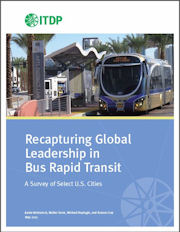 The Rail-to-Dulles project is a classic example of how the transit-selection process in the United States is rigged in favor of rail projects and seriously biased against buses, contends a new report, “Recapturing Global Leadership in Bus Rapid Transit,” published by published by the Institute for Transportation & Development Policy. States the report:
The Rail-to-Dulles project is a classic example of how the transit-selection process in the United States is rigged in favor of rail projects and seriously biased against buses, contends a new report, “Recapturing Global Leadership in Bus Rapid Transit,” published by published by the Institute for Transportation & Development Policy. States the report:
Numerous studies have shown that travel demand for large transportation infrastructure projects worldwide — especially rail projects — is frequently overestimated while costs are frequently underestimated, due to systematic optimism bias and strategic misrepresentation of project costs and benefits. Looking at 210 projects in fourteen nations, Bent Flyvbjerg found that nine out of ten rail projects overestimated passenger demand by an average of 106 percent. For seventy-two percent of rail projects, forecasts were overestimated by more than two-thirds. This bias is often a product of the political competition for public investment that pushes analysis to favor locally-preferred alternatives. …
Under current law, the [Federal Transit Authority] has minimal requirements for what types of alternatives must be included within an alternatives analysis. … Moreover, the project sponsor can modify the alternatives in ways that will change their cost-effectiveness ratings. [An] example of this deck-stacking technique is the 2002 Dulles Corridor (West Falls Church to Dulles Airport) Environmental Impact Statement, which considered fewer stations for BRT alternatives than for the metro-rail alternatives, and envisioned BRT as a closed system, running only on the new alignment. The analysis thus failed to consider the most obvious potential strength of a BRT option in the Dulles corridor — the ability for buses to operate off-corridor at one or both ends of their trip, picking up and delivering passengers at locations off the BRT corridor, while gaining travel time advantages from use of dedicated bus lanes in the corridor. Indeed, it is this ability of open-system BRT to deliver many more one-seat rides that can accrue significant environmental benefits by making mass transit attractive to a larger share of the potential travel market.
And why the bias for rail? Rail is backed by powerful constituencies like engineering firms, construction firms and labor unions coveting contracts to work on the often-massive projects (Dulles rail will cost more than $6 billion before it’s all done) and by land owners who stand to reap windfall gains in property values. By contrast, there is no local constituency for Bus Rapid Transit, the main beneficiaries of which are politically powerless out-of-state bus manufacturers.
Question of the day: Is it still too late to consider Bus Rapid Transit for Phase 2 of the Metrorail-to-Dulles project? Or has that train left the station?
(Hat tip: Larry Gross. For another take on this story, see Toll Road News.)
— JAB


